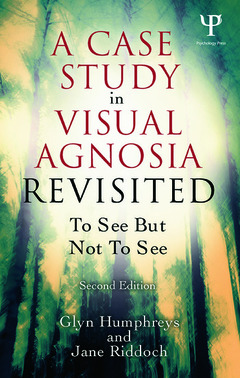A Case Study in Visual Agnosia Revisited (2nd Ed.) To see but not to see
Auteurs : Humphreys Glyn, Riddoch Jane

Visual agnosia is a rare but fascinating disorder of visual object recognition that can occur after a brain lesion. This book documents the case of John, who worked intensively with the authors for 26 years after acquiring visual agnosia following a stroke. It revisits John?s case over twenty years after it was originally described in the book To See But Not To See, in 1987. As in the previous book, the condition is illuminated by John and his wife, Iris, in their own words.
A Case Study in Visual Agnosia Revisited discusses John?s case in the context of research into the cognitive neuroscience of vision over the past twenty years. It shows how John?s problems in recognition can provide important insights into the way that object recognition happens in the brain, with the results obtained in studies of John?s perception being compared to emerging work from brain imaging in normal observers. The book presents a much fuller analysis of the variety of perceptual problems that John experienced, detailing not only his impaired object recognition but also his face processing, his processing of different visual features (colour, motion, depth), his ability to act on and negotiate his environment, and his reading and writing.
A Case Study in Visual Agnosia Revisited will be a key reference for those concerned with understanding how vision is implemented in the brain. It will be suitable for both undergraduate students taking courses in cognitive psychology and neuropsychology, and also researchers in the cognitive neuroscience of vision. The presentation of John?s case, and the human aspects of the disorder, will also be of great interest to a general audience of lay people interested in perception.
1. Serendipity 2. Meeting in a dressing gown 3. On becoming agnostic 4. The visual brain 5. A short history of agnosia 6. Integrative agnosia 7. Seeing the whole 8, What’s in a face? 9. Colour, movement, action! 10. The written word 11. Living with agnosia
Glyn Humphreys is Watts Professor of Experimental Psychology at the University of Oxford, UK. His research covers the diagnosis and management of cognitive problems after brain injury, visual attention, perception, language and the control of action, and social cognition. He has published over 500 papers in international journals and 16 books.
Jane Riddoch is Professorial Research Fellow at the University of Oxford, UK. Her research covers visual disorders (agnosia, optic aphasia), disorders of attention (neglect, extinction), and action (apraxia, action disorganisation syndrome) and neuropsychological rehabilitation. She has published 150 papers in leading international journals and authored/edited five books.
Date de parution : 10-2013
13.8x21.6 cm
Disponible chez l'éditeur (délai d'approvisionnement : 14 jours).
Prix indicatif 53,83 €
Ajouter au panierDate de parution : 10-2013
13.8x21.6 cm
Disponible chez l'éditeur (délai d'approvisionnement : 14 jours).
Prix indicatif 160,25 €
Ajouter au panierThème d’A Case Study in Visual Agnosia Revisited :
Mots-clés :
object; recognition; integrative; cognitive; neuropsychology; johns; drawing; unusual; views; apperceptive; Early Visual Regions; Visual Word Form System; Global Precedence Effect; Occluded Contours; Apperceptive Agnosia; OCC; Integrative Agnosia; Associative Agnosia; RAF Museum; Ventral Visual Stream; Topographical Agnosia; Visual Agnosia; Mary Hill; Structural Mri Scan; Word Red; Bold Response; Alexic Patients; Prosopagnosic Patients; FFA; Global Shape; Binocular Depth Cues; Mri Scan; Mri Analysis; Royal Tenenbaums; Hierarchical Letters



